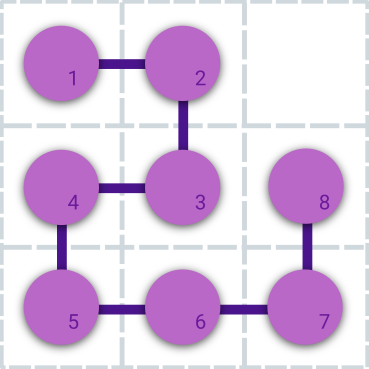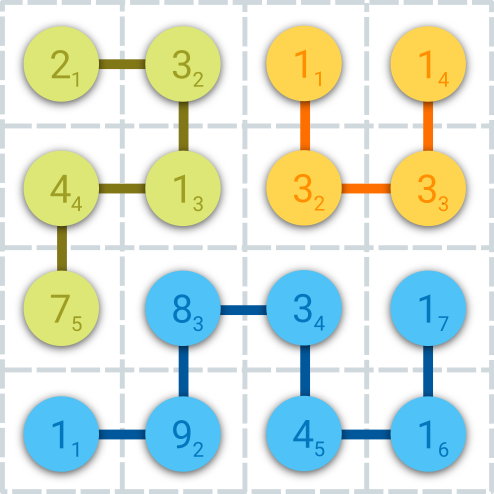E. Garlands
time limit per test 3 seconds
memory limit per test 256 megabytes
input standard input
output standard output
Like all children, Alesha loves New Year celebration. During the celebration he and his whole family dress up the fir-tree. Like all children, Alesha likes to play with garlands — chains consisting of a lightbulbs.
n × m for playing. The rows of the field are numbered from 1 to n from the top to the bottom and columns are numbered from 1 to m
k garlands which he places at the field. He does so in the way such that each lightbulb of each garland lies in the center of some cell in the field, and each cell contains at most one lightbulb. Of course lightbulbs, which are neighbours in some garland, appears in cells neighbouring by a side.

The example of garland placing.
Each garland is turned off or turned on at any moment. If some garland is turned on then each of its lightbulbs is turned on, the same applies for garland turned off. Each lightbulb in the whole garland set is unique, and thus, being turned on, brings Alesha some pleasure, described by an integer value. Turned off lightbulbs don't bring Alesha any pleasure.
all the garlands are turned on.
Alesha is still very little and can't add big numbers. He extremely asks you to help him.
Input
n, m and k (1 ≤ n, m, k ≤ 2000) — the number of field rows, the number of field columns and the number of garlands placed at the field respectively.
Next lines contains garlands set description in the following format:
len (1 ≤ len ≤ 2000) — the number of lightbulbs in the garland.
len lines contains three integers i, j and w (1 ≤ i ≤ n, 1 ≤ j ≤ m, 1 ≤ w ≤ 109) — the coordinates of the cell containing a lightbullb and pleasure value Alesha gets from it if it is turned on. The lightbulbs are given in the order they are forming a chain in the garland. It is guaranteed that neighbouring lightbulbs are placed in the cells neighbouring by a side.
q (1 ≤ q ≤ 106) — the number of events in Alesha's game. The next q lines describes events in chronological order. The i-th of them describes the i-th event in the one of the following formats:
- SWITCHi— Alesha turns offi-th garland if it is turned on, or turns it on if it is turned off. It is guaranteed that 1 ≤i≤k.
- ASKx1y1x2y2 — Alesha wants to know the sum of pleasure values the lightbulbs, placed in a rectangular part of the field. Top-left cell of a part has coordinates (x1,y1) and right-bottom cell has coordinates (x2,y2). It is guaranteed that 1 ≤x1 ≤x2 ≤nand1 ≤y1 ≤y2 ≤m. There is no more than 2000
All the numbers in the input are integers.
cin in codes on C++ and class Scanner in codes on Java.
Output
ASK
Examples
input
4 4 3
5
1 1 2
1 2 3
2 2 1
2 1 4
3 1 7
4
1 3 1
2 3 3
2 4 3
1 4 1
7
4 1 1
4 2 9
3 2 8
3 3 3
4 3 4
4 4 1
3 4 1
2
ASK 2 2 3 3
ASK 1 1 4 4
output
15
52
input
4 4 1
8
4 1 1
3 1 2
2 1 1
1 1 7
1 2 5
2 2 4
2 3 1
1 3 1
3
ASK 1 1 3 2
SWITCH 1
ASK 1 1 3 2
output
19
0
Note

This image illustrates the first sample case.
题意:给你一个n*m的矩阵,矩阵里面有k条链,然后有q次询问,每次询问(SWITCH)可以使得一条链变成0,或者使这条链变成原来的值,状态取反。然后查询(ASK)一个矩阵的权值和。
题解: 各种姿势的树状数组随便搞搞就可以了。因为出题人给的数据不强。询问也不过2000。
代码:
#pragma comment(linker, "/STACK:102400000,102400000")
//#include<bits/stdc++.h>
#include<stdio.h>
#include<string.h>
#include<algorithm>
#include<iostream>
#include<cstring>
#include<vector>
#include<map>
#include<cmath>
#include<queue>
#include<set>
#include<stack>
#include <utility>
using namespace std;
typedef long long ll;
typedef unsigned long long ull;
#define mst(a) memset(a, 0, sizeof(a))
#define M_P(x,y) make_pair(x,y)
#define rep(i,j,k) for (int i = j; i <= k; i++)
#define per(i,j,k) for (int i = j; i >= k; i--)
#define lson x << 1, l, mid
#define rson x << 1 | 1, mid + 1, r
const int lowbit(int x) { return x&-x; }
const double eps = 1e-8;
const int INF = 1e9+7;
const ll inf =(1LL<<62) ;
const int MOD = 1e9 + 7;
const ll mod = (1LL<<32);
const int N = 2010;
const int M=100010;
const int maxn=2e3+7;
template <class T1, class T2>inline void getmax(T1 &a, T2 b) {if (b>a)a = b;}
template <class T1, class T2>inline void getmin(T1 &a, T2 b) {if (b<a)a = b;}
int read(){
int v = 0, f = 1;char c =getchar();
while( c < 48 || 57 < c ){if(c=='-') f = -1;c = getchar();}
while(48 <= c && c <= 57) v = v*10+c-48, c = getchar();
return v*f;}
int n,m,q,p;
int flag[N],num[N],ok[N];
char str[20];
ll a[N][N];
struct fuck
{
int x,y,w;
}b[N][N];
void update(int x,int y,ll w)
{
int j;
while(x<=n)
{
j=y;
while(j<=m){
a[x][j]+=w;
j+=lowbit(j);
}
x+=lowbit(x);
}
}
ll getsum(int x,int y)
{
ll ans,j;
ans=0;
while(x>0)
{
j=y;
while(j>0){
ans+=a[x][j];
j-=lowbit(j);
}
x-=lowbit(x);
}
return ans;
}
/*
void update(int x,int y,int w)
{
for(int i=x;i<maxn;i+=lowbit(i))
for(int j=y;j<maxn;j+=lowbit(j))
a[i][j]+=w;
}
ll getsum(int x,int y)
{
ll ans = 0;
for(int i=x;i>0;i-=lowbit(i))
for(int j=y;j;j-=lowbit(j))
ans+=a[i][j];
return ans;
}
*/
int main()
{
#ifndef ONLINE_JUDGE
freopen("in.txt","r",stdin);
#endif
int i,j,k,x1,x2,y1,y2;
memset(flag,0,sizeof(flag));
scanf("%d%d%d",&n,&m,&p);
for(i=1;i<=p;i++)
{
scanf("%d",&num[i]);
for(j=1;j<=num[i];j++)
{
scanf("%d%d%d",&b[i][j].x,&b[i][j].y,&b[i][j].w);
}
ok[i]=1;
}
scanf("%d",&q);
while(q--)
{
scanf("%s",str+1);
if(str[1]=='S') //switch
{
scanf("%d",&k);
ok[k]^=1;
}
else //ask
{
for(i=1;i<=p;i++)
{
if(ok[i])
{
for(j=1;j<=num[i];j++)
{
update(b[i][j].x, b[i][j].y, b[i][j].w*((flag[i]==1?(-1):1)) );
}
flag[i]^=1;
ok[i]=0;
}
}
scanf("%d%d%d%d",&x1,&y1,&x2,&y2);
printf("%I64d\n",getsum(x2,y2)-getsum(x1-1,y2)-getsum(x2,y1-1)+getsum(x1-1,y1-1));
}
}
return 0;
}










